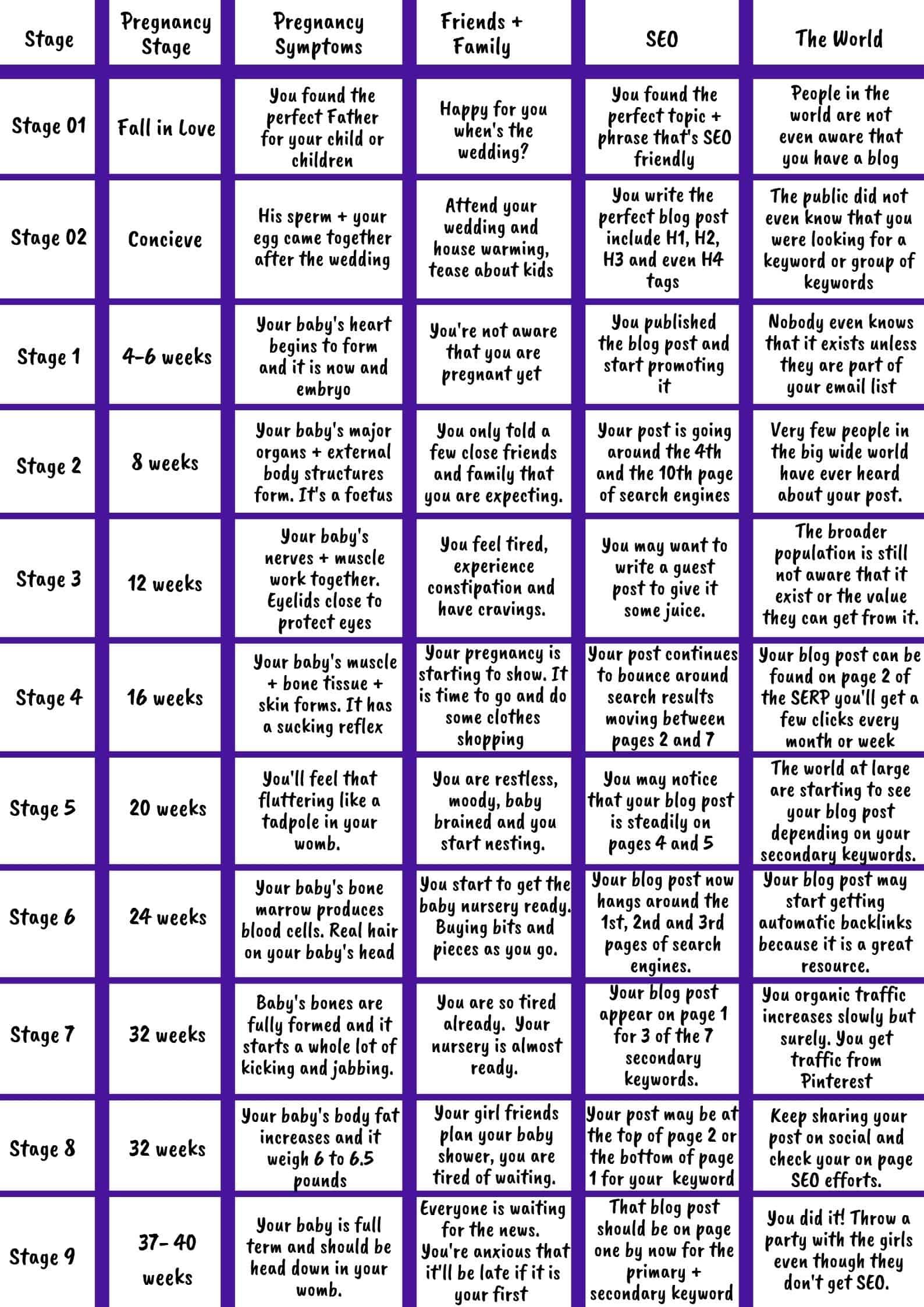Podcast: Play in new window | Download (Duration: 1:02:15 — 86.0MB) | Embed
Subscribe: Spotify | Amazon Music | Email | TuneIn | Deezer | RSS | More
Are you one of those mummy bloggers who know that you need SEO but you don’t know enough about it?
Maybe you have been blogging for more than a year now but you keep procrastinating when it comes to implementing SEO strategies for your blog.
Some mummy bloggers complain that SEO is so hard and they hope that one day they would get a chance to understand it.
You see many bloggers struggle with SEO because they are going about it the wrong way for someone who just wants to rank a keyword.
Many get lost in the sea of SEO jargon like keywords, H1 tags, H2 tags, meta description, keyword in URL and optimised images.
Especially, when it is not as complex as having a baby. If you are a Mother and you already had a baby then SEO is a breeze.
In this post, I am going to spend some time showing you how to make SEO relatable and how you can compare it with pregnancy.
You will see the 9 stages of pregnancy compared side by side with SEO and my hope is that you will realise that this SEO thing can be simple.
What is SEO Anyway?
I know that I have explained this previously in another post but just in case you don’t know here is the definition again.
SEO is the acronym for Search Engine Optimisation. In terms of definition, it is the art of optimising your web content.
The goal of this optimisation is to get your content to rank in the SERP (search engine results page aka Google™) so that it is visible to prospects.
The techniques used to optimise web content has a lot of technical names that can be foreign but a common language was needed for this skill.
Here is a brief glossary for on-page SEO techniques:
H1 tag
– the most important title of your blog post at the top that tells search engines what it is about. It is normally surrounded by <H1></H1> but invisible in the visual section of a post.
H2 tag
– the second most important titles normally used as subheadings throughout your blog post. It is normally surrounded by <H2></H2> but invisible in the visual section.
H3 tag
– the third most important titles normally called subtitles and used in your blog post for list items. It is normally surrounded by <H3></H3> but invisible in the visual section.

H4 tag
– the fourth most important item which can be found in list items of your blog post. It helps break up the hierarchy of your post. It is normally surrounded by <H4></H4> but these tags invisible in the visual section.
Meta description
– this is what would show up as the main description when your site is listed in the SERP. The meta description helps you to get the click.
Keyword or keyphrase
– think of it as the seed word that tells humans and bots what your site is all about. This is the backbone of any piece of content that helps to frame the purpose of that content.
Internal link
– the art of linking from one piece of content to the next in a proactive fashion to increase relevance in search rankings.
Keyword in URL
– placing your keyword in the URL helps with ranking in the search. For example, this is what it looks like when you go to share a link to your article if your keyword is “baby shoes” https://www.domain.com/baby-shoes
Include the keyword in the title
– ensure that the keyword that you would like to rank for is included in the title. For example, if your keyword is ‘baby shoes’ then try to include it in the title of your blog post.
Include the keyword in the first paragraph
– do include your keyword in the first 100 words of your blog post. The closer it is to the beginning the better it would be for your blog.
Keyword density
– this word might bring shivers down your spine as it might remind you of a science class at school. It just simply means the number of times your keyword appears in the body of your post. A percentage of 0.5% is a good balance.
Secondary keywords
– if you are putting in all this effort to rank for one keyword then include more than one. Throw in 7 other words so that your precious blog post can get more exposure.
LSI keywords
– LSI is the acronym for latent semantic indexing and this is what it means in layman’s terms. They are those words that an end-user expects to find in your content that is closely associated with your primary keyword. You can normally find them at the bottom of the SERP.
Optimised image
– ensure that your keyword is included in the name of your image. So, if your keyword is baby shoes then your image name may be “baby_shoes.png”‘
Page speed
– this one you may not be able to control 100% of the time. However, your page speed is the length of time it takes for your page to load when someone clicks through to it. Aim for less than 3 seconds. Find a good website host and keep them.
Domain Authority (DA)
– it is a number between 0-100 that is assigned to your domain based on a number of factors in Google algorithm. It just means that if you have a DA of 30+ you have a higher chance of ranking for your desired keyword compared to a DA of 10.
You can check the DA for your blog’s domain by visiting the Moz website here. You will need to create a free account.
I think I have included everything at this point so let’s move on to why SEO is important for mummy bloggers.

SEO for Mummy Bloggers
When you start a mummy blog you just want to get on with it and talk about your experience as a young mum or older mum.
You want to share your important tips and trick about pregnancy, going into labour, breastfeeding, colic and getting sufficient sleep.
Time is spent talking about the 1st, 2nd and third trimester and what it entails. Cures for cravings and sleeping better at night.
Nothing is better than talking about all the mother and baby gadgets. From prams, nappies, cribs, expressing breast milk, baby sleeping bags, etc.
These are all very important and they help you to bond with your readers. However, what is most important is the user experience.
If you wrote the perfect blog post about breastfeeding for mums but your potential readers cannot find you then it defeats the purpose.
Maybe some readers can only find you on social media but they cannot find you in Google anywhere.
Look at the SEO rules as a way to help your blog post be found in the search. There is no need to hate SEO just follow the rules and all will be well.
SEO is Simpler than Pregnancy
I really believe with all my heart that mummy bloggers could be bosses at optimising their content for SEO.
Why? Because SEO is technical and has many clear-cut rules that are simple to follow. Pregnancy, on the other hand, has so many complex elements.
Every pregnancy is different. For example, my first baby was a simple straightforward process. I had him at home.
My second pregnancy had so many possible complications that I had a special consultant that was ‘in charge’ of my case.
SEO is not at all like that unless you are trying to rank higher than Google itself. I’m not sure why you would want to do that though.
For mummy bloggers, SEO is a simple process. Choose a good keyword, follow the rules and you will rank well.

9 Stages of SEO Pregnancy
Say what? SEO and pregnancy both have 9 stages? Well, I decided to present it in this way in order to help my mummy bloggers get their head around it so here goes.


Now What Next for Mummy Bloggers?
The world of SEO is a never-ending process where you attempt to rank one piece of content after the next. It also involves keeping your existing first-page ranking.
This is why larger companies have a team of SEO experts to maintain those rankings. You see there are only 8-10 spaces on each SERP (aka Google™ page result).
Therefore, it is a constant struggle to keep your rankings, especially in more competitive markets.
However, for mummy bloggers, there isn’t an extreme need to keep your rankings at all. You just need to have a ranking report automatically sent to you every month so that you can check.
If you plan to get as big at Huffington Post then you will need to implement a number of SEO strategies.
The backbone to every blog post ranking process is getting the right keyword. If the chosen keyword is no good then you will not get the blog post to rank.
In fact, the honest truth is that finding the perfect keywords can be probably the most complex part of the process.
You can learn how to do this yourself (become a keyword expert). The other option is to just invest in a keyword research service that will hand it to you on a silver platter.
Would you like to achieve your blogging goals faster and to spend more time watching your children grow?
Keyword Research Service
After 10 years of experience in blogging and SEO, I have developed a custom Keyword Research Service for bloggers. It will save you a lot of time and frustration when it comes to finding keywords.
I even have a package designed for Mummy bloggers or Mommy bloggers depending on where in the world you are situated. For a low price of $27 a month, which is less than hiring a baby sitter for 3 hours you can propel your blog forward by leaps and bounds.
Skyrocket your blog’s organic traffic for the next 12 months by taking advantage of this package while the price is still low.
What’s Included In The Keyword Pack?
Are you unsure that this package is suitable for your requirements? Maybe you need to understand what’s included for that low price of $27 a month.
You’ll receive 1 x keyword pack every 2 weeks and here is what is included in each pack.
- A primary keyword (niche specific)
- 5-7 secondary keywords
- A summary of what your blog post should be written about
- Top 30 Instagram hashtags for your content
- Video suggestions
- Further suggestions for other media like screenshots, charts, graphs
- Access to Pin image templates
- Done for you keyword analytics
Get started today to stay ahead of other bloggers in your niche. There are only very few spaces available so they will fill up fast, sign up here.
Why Use a Keyword Research Service?
- As a Mummy Blogger, your time is very limited so you need to decide what blogging activity will give you the highest return on investment.
- Keyword research takes a lot of precious time and is better done by an SEO expert to get the best results every time.
- Blogging can be time-consuming and stressful so spend time doing the things you love compared to the things you dislike.
- No need to spend time studying SEO every month trying to understand the latest trends. Leave this task to someone like me who loves it.
- I am a Mummy like you so I get it. Your time is better spent with your children because they grow so quickly. Avoid having regrets later of not spending time with your family.
- For $27 a month it is less than the cost of hiring childcare for 3 hours so there’s no need to feel guilty about letting someone else handle it.
Conclusion
As you can see getting your blog to rank higher in Google™ is a very simple process if you follow the rules or code.
To summarise here are the steps that have been outlined above:
- Find a solid primary keyword
- Get the corresponding LSI keywords
- Expand to secondary keywords as needed
- Write the blog post
- Optimise it to include all the tags (H2, H3, H4)
- Include the keyword in the URL
- Ensure the keyword is included in the first 100 words
- Write a clickable meta description
- Have a keyword density of 0.5%
- Ensure the images are optimised with keywords
- Include the keyword in the title (H1)
- Link to other related posts on your blog
- Place links from other blog posts to this new one after publishing
- Link external to other reputable sites
- The higher your domain authority the easier it would be to rank for your choice of keywords
I know that there will be some SEO experts who would like to add more complex items to this list like trust flow, citation flow, backlink weighting and many other things.
This is all you need, for now, it is just the basics that you need to get started and see results. Is that okay mummy bloggers?
Now I am so anxious to find out if all you mummy bloggers found this helpful and can relate to it in any way.
Do you have any other pertinent questions that you would like to ask me? Leave it in the comments and I will answer them.

Announcements
Subscribe to the Success Unscrambled Podcast where you will be the first to hear what’s happening in the entrepreneurial and digital marketing world.
Your review of this podcast is vital to keeping it alive and running for the next 12 – 24 months so please leave a review for us on iTunes, Spotify or any of your favourite podcast players.
In case you missed it check out the importance of affordable SEO packages as well as how to find profitable untapped niche markets.
Want to take advantage of some free traffic to your blog from Pinterest? Check out my Pinterest SEO tips here.
If you are a startup or small business and you need to hire a virtual assistant to complete tasks such as social media marketing, blogging, keyword research or Pinterest account management then take a look at these packages.


62 thoughts on “SEO for Mummy Bloggers: Everything You Need To Know”
I wish I was aware of all these SEO tips when i first started blogging. I couldn’t agree more. Most people get completely lost in the SEO world unfortunately.
Yes Konstantina, I also wish that I knew all of this when I entered blog land. Thanks for stopping by.
I dislike acronyms and jargon so I skipped ahead to unscramble the acronym and breathed a sigh of relief. Would probably hire you to optimize my blog rather than doing it myself ?
That’s hilarious Ria, thanks for stopping by.
This is a very good article for anyone who doesn’t understand SEO. II had so many doubts cleared here. Great post, thanks for sharing!
That’s awesome. Thanks for your feedback
I am still learning about SEO and trying to get better with them. This is helpful to keep in mind for sure. That podcast sounds awesome too!
Great Amber, thanks for your feedback
what a comprehensive list you got here! not pregnant here and no kids too but i can easily see how useful this can be!
Yes Patricia-Ann, it does work in other niches as well.
This is great! SEO can seem so complicated, but once you get a handle on it it really makes sense. I have been working on my SEO for a while and it really makes a huge difference.
Jessi, I’m so glad that you are getting results. Thanks for your feedback.
You seriously have the perfect podcasting voice! So easy to listen to and this a great topic! Thank you for the tips!
Thanks for the compliment Tisha, so glad you found it valuable.
Great tip about the key word in the title. I need to try some of these tips.
Thanks for the feedback Tara.
SEO was so complicated for me at first. Whatever i was doing, it never worked, but it is much better now, although this is a great reminder and i also learnt quite a few things!
Awesome Corinne, thanks for instilling more confidence in my readers that SEO can be less complicated. I’m glad you learned something new.
Great post! I dont even know where to start when it comes to SEO, so this is perfect for me!
Jessica, so glad that you found this useful.
Although I’m not a mom yet, I find this post helpful!! Thanks for sharing this information, I’m really tryinghard to make everything optimized bynow! haha
Awesome Sandra, thanks for stopping by.
I love how you compared it to pregnancy. And yes, nothing can harder than pregnancy.
Devyani, it is interesting how we forget the pain of pregnancy and go for baby number two.
This a great resource for me as a brand new blogger. I am still learning about SEO and trying to get my blog posts out there. I looked up one of my keywords the other day and I searched down to probably the 10th page of Google and I still never found it. *womp womp* Obviously I still have work to do
Whatever you do Carli, don’t give up. Just keep at it. Do let me know if you have any questions.
SEO is one of those things that definitely takes work. These are some really great tips!
Yes Becca, the reward that you get from SEO is also very sweet.
Thank you for explaining SEO in easy-to-understand terms. I wish I had the time to keep pushing every blog post after I write it. I do all of my SEO stuff up front, but I’m afraid after the first week or two, I’m done with it, and I move on. I need to do better. There’s just not enough time in a day!
Heidi, one creative way to keep working on your SEO is creating new Pinterest pins for your posts and using Recurpost for your Twitter and Facebook accounts. In other words, make it a fun job rather than dull and boring.
Great jobs, this is a indepth guide and great one for mommy bloggers!
Thanks for the compliment Aisasami.
I had no idea what seo was. This was very helpful information.
Kay, I am glad you found it helpful.
SEO is so confusing sometimes. Thank you for the tips.
Vanessa, SEO can be confusing at times. Thanks for stopping by.
It’s a very helpful information. I love the way how you described it.
Bindu, that’s awesome. Thanks for your feedback.
Wow, good way to go! I want go start blogging too. It is just a relief that some bloggers share their knowledge for newbies like me.
Hannah, starting a blog is pretty straight-forward. I have a free course on it here.
I have been trying to improve my seo for the last few months. It is really difficult, but I think I am beginning to get the hang of it.
That’s awesome Stephanie. Thanks for sharing.
This is so hepful!! I’m new to SEO and this article just made it so much easier to understand 🙂 Thank you!!!
You are so welcome Anna, I’m glad you got the help you needed.
This was a cute and fun way to get people to learn more about SEO! Thanks for doing this informative post 🙂 xo, Suzanne
Suzanne, I’m so glad that you found it fun and cute as that was my intention. So glad that it was informative.
I keep hearing about what a difference checking SEO makes to blog traffic. I think I’m going to have to go through all of my old posts and check on that.
Maria, it may be more valuable to spend time optimising your new blog posts rather than too much time fixing the old ones.
Awesome share.!!!!!!!! .Your article will help me.Thanks for sharing this amazing post.
Kavleen, you are very welcome.
Okay I am no Mummy, but I really love your post. Good work buddy really informative
Comments are closed.